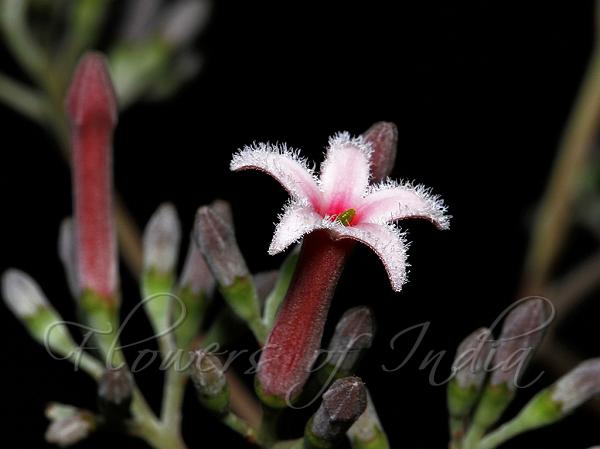|
| Quinine |
|

|

| File size | 124325 |
| Original date | 8/28/18 11:21 AM |
| Resolution | 1024 x 768 |
| Flash | Flash fired |
| Focal length | 100.0mm |
| Exposure time | 1/250s |
| Aperture | 16.0 |
| Focus Distance | |
| Metering Mode | Spot |
| Camera make | Canon |
| Camera model | Canon EOS 7D |
| Sensor type |
|
|
|
|
Photo: |
Botanical name: Cinchona pubescens Family: Rubiaceae (Coffee family)
Synonyms: Cinchona cordifolia, Cinchona colorata, Cinchona succirubra
Synonyms: Cinchona cordifolia, Cinchona colorata, Cinchona succirubra
Quinine is an evergreen tree or shrub, up to 12 m
tall. This is the most frequently cultivated species of Cinchona.
Flowers are white or pink, outside becoming hairless to velvet-hairy;
tube cylindrical, 8.5-14 mm; petals ovate-lanceshaped, 4-6 mm, pointed.
Calyx with ovary portion ellipsoid, 2-3 mm, densely pilosulous; limb
1.5-3 mm, sparsely to densely hairy, shallowly lobed; sepals
triangular, 0.5-1 mm. Flowers are borne in clusters 6-23 cm across,
hairy to finely velvet-hairy; bracts triangular, 0.5-3 mm;
flower-stalks 1-3 mm. Leaf-stalks are 1.5-4 cm, leaf blade drying
papery, ovate, ovate-elliptic, or elliptic-oblong, 10-24.5 x 5.5-17 cm,
often reddened at least when young, base blunt to rounded or flat, tip
blunt to rounded; secondary veins 6-11 pairs, stipules 10-25 mm.
Capsules are 10-18 x 5-7 mm, seeds 7-12 x 2-3 mm (including wing). Quinine is
native to Eucador, globally distributed in Columbia, Peru and Bolivia.
It is cultivated in South India and Sri Lanka. It has been recorded in
West Bengal and Nilgiris. It thrives well at higher elevations up to
2600 m in South India. Flowering: June-February.
Medicinal uses: Quinine has a long history of
native use, especially as a treatment for fevers and malaria. Modern
research has shown it to be a very effective treatment for fevers, and
especially as a treatment and preventative of malaria. The birth of
homeopathy was based on quinine.
Quinine has a long history of
native use, especially as a treatment for fevers and malaria. Modern
research has shown it to be a very effective treatment for fevers, and
especially as a treatment and preventative of malaria. The birth of
homeopathy was based on quinine.
Medicinal uses:
 Quinine has a long history of
native use, especially as a treatment for fevers and malaria. Modern
research has shown it to be a very effective treatment for fevers, and
especially as a treatment and preventative of malaria. The birth of
homeopathy was based on quinine.
Quinine has a long history of
native use, especially as a treatment for fevers and malaria. Modern
research has shown it to be a very effective treatment for fevers, and
especially as a treatment and preventative of malaria. The birth of
homeopathy was based on quinine. | Identification credit: Santhosh Kumar E.S. | Photographed in Nilgiris, Tamil Nadu. |
• Is this flower misidentified? If yes,